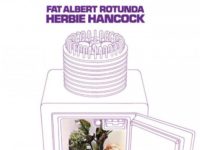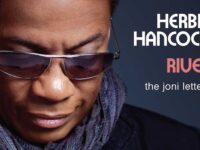Former collaborators Bill Summers and Mike Clark join us as we sort through a handful of ageless moments from the forthcoming Herbie Hancock box set, The Complete Columbia Album Collection.
Of course, Hancock has been there, often in a pivotal role, for nearly every major cataclysm in jazz since the early 1960s – and his tenure with Columbia captured many of those moments.
Missing, of course, are his early Blue Note solo efforts, and all of the explosive innovations of his time with Miles Davis. But, as this 34-CD box set – due November 12, 2013 via Legacy Recordings – makes clear, there was still much more to be discovered, and to be enjoyed, from Herbie Hancock’s ever-changing, ever-challenging career.
Covering a strikingly diverse period between 1972 and 1988 as Hancock released roughly two albums a year, The Complete Columbia Album Collection underscores Hancock’s frisky sense of adventure, both in acoustic and electronic music. That one of the keyboardist’s best-known songs from this box is called “Chameleon” ultimately comes as little surprise.
And even if you thought you had everything there was to own, The Complete Columbia Album Collection surprises with eight separate titles that never saw release outside of Japan. Along the way, there are career intersections with fellow Davis alumni like Wayne Shorter, Ron Carter and Tony Williams; as well as Jaco Pastorius, Carlos Santana, Freddie Hubbard and Bennie Maupin.
Their story — through the prism of Hancock’s out-sized imagination — is told in song, then expanded through extensive notes from Bob Beldon and Hancock historian Max Schlueter, as well as a profile of producer David Rubinson — who oversaw all but six of this set’s featured albums.
What you hear, most of all, is Hancock’s sensitivity, to the music, to the beats of the streets, to his own muse. Clark, in an exclusive Something Else! Sitdown, says Hancock “heard everything that you did. It was like being tracked by some kind of radar mechanism. He heard every breath that you took while you were playing; he felt all of the vibes.”
Now, you can too …
HEAD HUNTERS (1973): Hancock assembled a new band with only the underrated Bennie Maupin remaining from his previous sextet for this record, and the Headhunters were born. Together with funk bassist Paul Jackson, the multi-cultural percussionist Summers and drummer Harvey Mason, Hancock would fashion a hit of previously unimagined proportions: Head Hunters went gold within months in America, sparked by a single edit of the titanic groover “Chameleon.” Ultimately, it would become the first-ever platinum-selling jazz recording.
A sign of Hancock’s willingness to push his own art to new places was a reworking of “Watermelon Man,” from his debut solo effort. The only cover among the four tracks on Head Hunters, the track is endlessly enlivened by Summers’ inventive asides — including the use of a bottle that imitated the hindewho instrument used by the Mbuti pygmies of northeastern Zaire.
“There’s multiple parts on there, actually five parts stacked on top of each other,” Summers tells us. “One part, I learned from a group of people in Congo, who use this one-note cane flute. It just produces one note; the rest of it is the voice. On the main part, I didn’t have a pipe that was pitched in the right key, so I took a bottle and filled it up with water until it was a middle C. That’s a technique I learned from the pygmies.” — Nick DeRiso
LIVE UNDER THE SKY (1979): The V.S.O.P. quintet began touring in 1977, after Miles Davis declined to rejoin a new iteration of his classic 1960s unit. In his place with Hancock, Wayne Shorter, Ron Carter and Tony Williams, stepped trumpeter Freddie Hubbard. Initially, this amalgam was to perform a single time as part of the 1976 Newport Jazz Festival — and thus the name, which stood for Very Special One-time Performance. But no small amount of magic ensued, and the group continued forward, producing a studio album and three live sets between 1976-79.
Recordings like Live Under the Sky, from a Japanese musical festival held in July 1979, helped provide a spark that arguably ignited the acoustic jazz renaissance of the early 1980s, after years of fusion and rock-infused experimentation. Hubbard simply soars, moving from delicate wonder to fiery retorts amid a storm of hard-charging energy from a group of tight-knit old friends.
That all of this happened in a torrential downpour makes it just that much more amazing. Shorter, in particular, is a wonder of improvisational inventiveness — offering quicker, sharper thoughts as his reed becomes increasingly soggy. Across a set that moves with ease between head-wagging burners (Hancock’s “Eye of the Hurricane,” Hubbard’s “One of Another Kind”) and ephemeral balladry (Carter’s “Tear Drop”), V.S.O.P. made a case not just for their own prodigious talents but for straight-ahead jazz itself. — Nick DeRiso
THRUST (1974): When Mason’s other obligations kept him from touring with the Head Hunters band, Oakland-based Mike Clark stepped in — adding his own unique flavors to their live sound and to Thrust, the follow up to 1973’s Head Hunters. Very much in keeping with its predecessor, the stand-out track “Actual Proof,” with its frenetic Jackson bass line, was actually a left over from the earlier sessions — re-recorded here to include Clark’s forward-thinking contributions.
“It was very much like playing a straight-ahead jazz piece, but I used a big funk set — it had a big sound,” Clark tells us. “If I had played on an 18-inch drum, on a small bebop kit, it would have sound more like jazz. That gave it a different spin, and plus the beat was not swing, it was funk. So, that’s the whole deal.”
“Palm Grease,” which opens the album, is powered by a gurgling Latin-flavored contribution by Summers, while “Butterfly” offers a lush setting for Maupin to explore. “Spank-A-Lee” wraps everything up with a titanic groove, all in homage of early-1970s-era funk. — Nick DeRiso
MR. HANDS (1980): Hancock had established himself as a funk-jazz godfather with Head Hunters and Thrust, but each successive record after those (save for the excursions back into straight-ahead jazz) yielded diminishing results. By the time of Feets Don’t Fail Me Now, Hancock had diluted away all the jazz elements in his contemporary music, leaving us with music devoid of the imagination, vision and improvisation that set his earlier works well apart from the R&B and fusion of its time.
Hancock must have felt himself going adrift, as he forcefully righted the ship again at the beginning of the new decade with Mr. Hands. It is, quite frankly, the best Hancock fusion record of the ’80s — with apologies to those who’d argue for Future Shock. Though Mr. Hands arrived three years before that with much less fanfare, it has held up much better over the years, working not so much as a milestone in the leader’s rich musical history but as a summation of some his better crossover tendencies of the prior decade.
He was still using a roomful of synthesizers, but he’d learned to leverage them well — applying them creatively to take the place of other instruments like steel drums on “Calypso” or a lead guitar on “4 A.M.,” a summit meeting with Pastorius. This record is also a curtain call of sorts for the original Head Hunters: the old crew gets back together for restless “Shiftless Shuffle” which could have been a comfortable addition to that 1973 blockbuster. “Just Around The Corner” with an entirely different roster matches the best funk of the Hunters with Freddie Washington’s slayin’ bass line to go with Hancock’s thoughtful Rhodes solo in the extended bridge section. — S. Victor Aaron
VILLAGE LIFE, with FODAY MUSA SUSO (1985): Suso, a kora player from Gambia, joined Hancock for a rare duo recording, having sat in on 1984’s Bill Laswell collaboration Sound System. But Village Life is a complete departure from tracks like “Junku,” which combined street beats with Suso’s beautifully constructed lines.
Instead, the album — recorded live in a Tokyo studio, and sounding every bit like a lively conversation caught on tape — provides another left turn in a career now closely associated with them, as Hancock and Suso offer four gorgeous and utterly pastoral meditations. Susa adds talking drum to his delicate, zither-like thoughts on the kora, while Hancock typically explores more contemplative sounds on a Yamaha DX-1. It is, quite simply, an enchanting meeting of the minds. Perhaps nowhere else is Hancock’s core life principle of inclusion — as taught through his conversion to Nichiren Shoshu Buddhism — made more self evident.
Hancock had, of course, been combining synthesized sounds and indigenous African elements for years. But there’s something special about this spacious recording, which allows another unadorned voice to so often intertwine with his own. The results are somehow both ethereal and earthy. Of course, in the wake of Hancock’s pop-star success with Laswell on “Rock-It,” Village Life was roundly ignored. The jazz guys didn’t know what to do with this, either. But the album’s elliptical allures remain, long after MTV has stopped playing music videos all together. — Nick DeRiso




